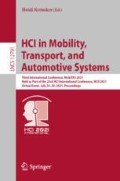Abstract
The development towards autonomous driving is about to change our future mobility. Though there is public consent on perceived benefits of autonomous driving, potential drawbacks are also considered. In this survey, we focused on the user-centered assessment of autonomous driving in comparison of two traffic scenarios (“city” vs “highway”) using an online questionnaire. Participants were generally more affirmative in regard to using autonomous vehicles on the highway than in the urban area. Attributions measured on a semantic differential were more positive with respect to highway use. Motives regarding the use of autonomous vehicles differed between the scenarios, mainly in terms of the simplicity and complexity of the driving situation, with autonomous vehicles being considered feasible for highways but not for cities. However, some evaluation patterns were independent of the context, revealing controversial attitudes and perceived trade-offs in both scenarios. Participants indicated positive expectations regarding the novel transport experience, but also fears of use, mainly described in terms of control issues. Findings of this survey can be used in further research in the field of human-automation interaction and build the basis for education and communication concepts to increase public awareness.
Access this chapter
Tax calculation will be finalised at checkout
Purchases are for personal use only
Notes
- 1.
Note: The scenario description was translated from German. 50 km/h is a maximum speed limit in German built up areas, corresponding to approx. 31 mph.
- 2.
Note: The scenario description was translated from German. 130 km/h is an advisory speed limit on German highways, corresponding to approx. 81 mph.
References
Bjørner, T.: A priori user acceptance and the perceived driving pleasure in semi-autonomous and autonomous vehicles. Paper presented at European Transport Conference 2015, Frankfurt, Germany, pp. 1–13 (2015)
Brell, T., Philipsen, R., Ziefle, M.: sCARy! Risk perceptions in autonomous driving: the influence of experience on perceived benefits and barriers. Risk Anal. 39(2), 342–357 (2019)
Federal Statistical Office: Bildungsstand (2020). https://www.destatis.de/DE/Themen/Gesellschaft-Umwelt/Bildung-Forschung-Kultur/Bildungsstand/_inhalt.html
Fraedrich, E., Lenz, B.: Automated driving: individual and societal aspects. Transp. Res. Rec. 2416(1), 64–72 (2014)
Gkartzonikas, C., Gkritza, K.: What have we learned? A review of stated preference and choice studies on autonomous vehicles. Transp. Res. Part C Emerg. Technol. 98, 323–337 (2019)
Harper, C.D., Hendrickson, C.T., Mangones, S., Samaras, C.: Estimating potential increases in travel with autonomous vehicles for the non-driving, elderly and people with travel-restrictive medical conditions. Transp. Res. Part C Emerg. Technol. 72, 1–9 (2016)
Igliński, H., Babiak, M.: Analysis of the potential of autonomous vehicles in reducing the emissions of greenhouse gases in road transport. Procedia Eng. 192, 353–358 (2017)
König, M., Neumayr, L.: Users’ resistance towards radical innovations: the case of the self-driving car. Transp. Res. Part F 44, 42–52 (2017)
Olaverri-Monreal, C.: Autonomous vehicles and smart mobility related technologies. Infocommunications J. 8(2), 17–24 (2016)
Payre, W., Cestac, J.J., Delhomme, P.: Intention to use a fully automated car: attitudes and a priori acceptability. Transp. Res. Part F: Traffic Psychol. Behav. 27(Part B), 252–263 (2014)
SAE: Taxonomy and definitions for terms related to driving automation systems for on-road motor vehicles. J3016. Technical report, SAE International (2018). https://www.sae.org/news/2019/01/sae-updates-j3016-automated-driving-graphic
Schmidt, T., Philipsen, R., Ziefle, M.: Safety first? V2X - Percived benefits, barriers and trade-offs of automated driving. In: Proceedings of the 1st International Conference on Vehicle Technology and Intelligent Transport Systems (VEHITS-2015), pp. 39–46 (2015)
Trübswetter, N.M.: Akzeptanzkriterien und Nutzungsbarrieren älterer Autofahrer im Umgang mit Fahrerassistenzsystemen. Ph.D. thesis, Technische Universität, München (2015)
VDA (Verband der Automobilindustrie): Automatisierung. Von Fahrerassistenzsystemen zum automatisierten Fahren. Technical report, Verband der Automobilindustrie (2015)
Acknowledgments
The authors thank all participants for their openness to share opinions on autonomous driving. Special thanks are given to Farina Heilen for research assistance. This work has been funded by the Federal Ministry of Transport and Digital Infrastructure (BMVI) within the funding guideline “Automated and Networked Driving” under the project APEROL with the funding code 16AVF2134B.
Author information
Authors and Affiliations
Corresponding author
Editor information
Editors and Affiliations
A Appendix
A Appendix
City Traffic Scenario. Please imagine that you are driving in an autonomous vehicle in the city. You have already scheduled the start and destination of your trip. The vehicle system takes over all driving tasks. You are driving at 50 km/hFootnote 1 on a moderately busy road, with another vehicle ahead of you at a sufficient distance. A traffic light turns red, your vehicle stops and starts again when the light changes back to green, then turns right into a side street. After some time, you reach a crosswalk where a pedestrian wants to cross the street. Your vehicle stops for the pedestrian to pass and then continues driving (Fig. 4).
Highway Traffic Scenario. Please imagine that you are driving in an autonomous vehicle on the highway. You have already scheduled the start and destination of your trip. The vehicle system takes over all driving tasks. You are driving at 130 km/hFootnote 2 on a moderately busy two-lane highway, with another vehicle ahead of you at a sufficient distance. Your vehicle starts an overtaking maneuver, it swerves and, after completing the maneuver, rejoins the lane. After some time, you reach a slip road, another vehicle is in the acceleration lane. Your vehicle swerves again and rejoins the original lane after having passed the acceleration lane (Fig. 5).
Rights and permissions
Copyright information
© 2021 Springer Nature Switzerland AG
About this paper
Cite this paper
Biermann, H., Philipsen, R., Brell, T., Himmel, S., Ziefle, M. (2021). Users’ Expectations, Fears, and Attributions Regarding Autonomous Driving – A Comparison of Traffic Scenarios. In: Krömker, H. (eds) HCI in Mobility, Transport, and Automotive Systems. HCII 2021. Lecture Notes in Computer Science(), vol 12791. Springer, Cham. https://doi.org/10.1007/978-3-030-78358-7_13
Download citation
DOI: https://doi.org/10.1007/978-3-030-78358-7_13
Published:
Publisher Name: Springer, Cham
Print ISBN: 978-3-030-78357-0
Online ISBN: 978-3-030-78358-7
eBook Packages: Computer ScienceComputer Science (R0)



